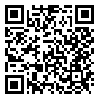Volume 7, Issue 4 (3-2021)
Human Information Interaction 2021, 7(4): 1-14 |
Back to browse issues page
Download citation:
BibTeX | RIS | EndNote | Medlars | ProCite | Reference Manager | RefWorks
Send citation to:



BibTeX | RIS | EndNote | Medlars | ProCite | Reference Manager | RefWorks
Send citation to:
Tahmasebi Limooni S. Discovering the Underlying Components Affecting the Usability of IoT in Iranian Libraries: A Theory Based on Context. Human Information Interaction 2021; 7 (4)
URL: http://hii.khu.ac.ir/article-1-2950-en.html
URL: http://hii.khu.ac.ir/article-1-2950-en.html
Babol Branch, Islamic Azad University, Babol, Iran
Abstract: (7098 Views)
Objective: The aim is to discover the underlying context components of IOT usability in Iranian libraries: A qualitative approach consistent with grounded theory.
Method: This qualitative study was conducted based on grounded theory. Data were collected through semi-structured interviews with 13 faculty members of knowledge and information science based on purposeful and chain methods. Responsive and inter-docking method (repeatability index) had been used for validity and reliability.
Findings: By reviewing the texts and propositions obtained from the interviews, 7 basic components of IoT usability in Iranian libraries were identified from 36 categories and concepts. These include communication and exchange of information, awareness and cognition, intelligences, Information findability, information literacy, self-reliance and automating, and structures and infrastructures.
Conclusion: The identified underlying components provide a suitable platform for the rule and realization of the main phenomenon of IoT usability in Iranian libraries. Based on the results, the paradigm and theoretical model of IoT usability is drawn and presented in Iranian libraries. By identifying the underlying components and their relationship in the theoretical model and based on the attitudes of interviewees in Iranian libraries, libraries could use it to establish and implement IoT.
Method: This qualitative study was conducted based on grounded theory. Data were collected through semi-structured interviews with 13 faculty members of knowledge and information science based on purposeful and chain methods. Responsive and inter-docking method (repeatability index) had been used for validity and reliability.
Findings: By reviewing the texts and propositions obtained from the interviews, 7 basic components of IoT usability in Iranian libraries were identified from 36 categories and concepts. These include communication and exchange of information, awareness and cognition, intelligences, Information findability, information literacy, self-reliance and automating, and structures and infrastructures.
Conclusion: The identified underlying components provide a suitable platform for the rule and realization of the main phenomenon of IoT usability in Iranian libraries. Based on the results, the paradigm and theoretical model of IoT usability is drawn and presented in Iranian libraries. By identifying the underlying components and their relationship in the theoretical model and based on the attitudes of interviewees in Iranian libraries, libraries could use it to establish and implement IoT.
References
1. Asnafi,A. R., Shima Moradi, SH., Sahar Razavi, S.(2020). Using the Internet of Things in Academic Libraries based on the views of the Librarians of Top Academic Central Library in Iran, Knowledge Studies, 5(19). (Persian)
2. Atzori, L., Iera, A., Morabito, G. (2010). The internet of things: A survey. Computer networks, 54(15), 2787-2805. [DOI:10.1016/j.comnet.2010.05.010]
3. Behpour, Z., Shoaei, H., Nabi Meybodi, M. (2020). Recognition of property components based on theoretical foundations arising from the field; In order to explain the place of the concept of ownership in the field of construction, Urban Management, 54, 27-44.(Persian)
4. Creswell, J.W. (2012). Educational research: planing,conducting and evaluating quantitive and qualitive research .4th. ed. By Perason education
5. Gopta, J., Singh, R. (2018). Internet of Things(IOT) and Academic Library. 5th International Symposium on Emerging Trends and Technologies in Libraries and Information Services, IEEE.
6. Groaut, L., Wang, D. (2015). Research Methods in Architecture, translated by Alireza Einifar, University of Tehran Press.(Persian)
7. Habibi, R., Al-Sheikh, A. A. (2018). Evaluation of spatial interpolation services in the development of air pollution monitoring systems based on IoT, Geomatics science and technology 6 (4).(Persian)
8. Hafeznia, M.R. (2017). Introduction to Research Methodology in Humanities, Tehran: Samt.(Persian)
9. Karimi, S., Nasr, A. R., (2013). Methods of Analyzing Interview Data, Research, 4 (1), 7. (Persian)
10. Kit,c. n., Ho Wu, c., Yung, k. l., , h., Cheung, t. (2018). A semantic similarity analysis of Internet of Things, Enterprise Information Systems, DOI: 10.1080/17517575.2018.1464666. [DOI:10.1080/17517575.2018.1464666]
11. Kumar, A., Kumar, S. (2019). Application of Internet of things in libraries: A scintometric Assessment of Gloal Publications Outpot During 2013-2019, Librarianship Development through Internet of things and customer Services, International Conference Proceeding. 368- 374.
12. Kumar, P. J. R. (2018). Application of Internet of Things for Smart Libraries: An Overview, International Journal of Multidiciplinary Educational Research. 7(2).
13. Lindelf, T. R. (2009). Qualitative Research Methods in Communication Sciences, Tehran: Hamshahri. (Persian)
14. Mansoorian, Y. (2007). What is grounded theory and what is its application? Conference on Information Science Challenges, University of Isfahan, Isfahan: Information Science Challenges, June 9 and 10, 2007.(Persian)
15. Noori Hassanabadi, K., Sobhani, A., Hashemzadeh Khorasgani, Gh., Abbaspour Esfadan, Gh.(2021). Presenting a model of quality improvement or the use of emerging technology in school intelligence, Scientific Journal of School Management, 8 (1).(Persian)
16. Pandya, K, Chintan (2018). 360 Degree Approach to Internet of Things (IOT) and It,s Application to the Libraries, International Conference on Internet of things and Current in Libraries (TTCTL).
17. Patil, H. J., Patil, D. T.(2018). Internetof Things & Application to the libraries, International conference on Internet of things and Current Trends in Libraries (ITCTL).
18. Parhizgar, M.,. Mehdi, A., Afroozi, A. A.(2019). Advanced Research Methodology in Management with Applied Approach (Master of Management, Tehran: Payame Noor University. (Persian)
19. Straus, A. Corbin, J. (2008). basics of Qualitative Research: Techniques and procedores for Developing Grounded Theory. Tthird edition. Sage publications. [DOI:10.4135/9781452230153]
Send email to the article author
| Rights and permissions | |
 | This work is licensed under a Creative Commons Attribution-NonCommercial 4.0 International License. |






